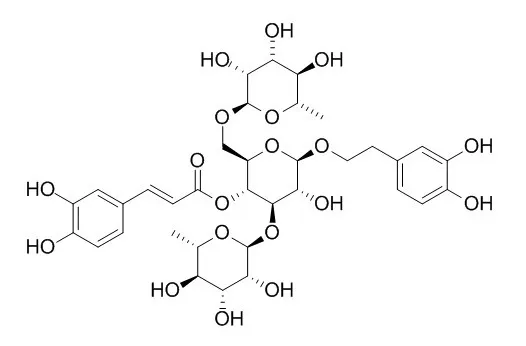| In vitro: |
| Biol Pharm Bull. 2009 Dec;32(12):1952-6. | | Total peroxynitrite scavenging capacity of phenylethanoid and flavonoid glycosides from the flowers of Buddleja officinalis.[Pubmed: 19952410] |
METHODS AND RESULTS:
Nine compounds, including six phenylethanoid glycosides: acteoside (1); bioside (2); echinacoside (3); Poliumoside (4); phenylethyl glycoside (5); salidroside (6) and three flavonoids; linarin (7); apigenin (8); isorhoifolin (9), were isolated from the flowers of Buddleja officinalis MAXIM. (Buddlejaceae). Chemical structures were confirmed by (1)H-, and (13)C-NMR, and MS spectral methods and compared with those reported in the literature. Antioxidant activities of the methanol and water extracts, and all isolated compounds were evaluated using the total oxidant scavenging capacity (TOSC) assay against peroxynitrite.
CONCLUSIONS:
Results of the assay showed that the phenylethanoid glycosides, a major class of compounds of the flowers of B. officinalis, possess strong antioxidant activity. Of these, acteoside, echinacoside and Poliumoside have 9.9-, 9.8- and 9.5-fold TOSC value, respectively, compared with the positive control, Trolox. | | Planta Med. 2013 Dec;79(18):1705-9. | | Caffeoylated phenylpropanoid glycosides from Brandisia hancei inhibit advanced glycation end product formation and aldose reductase in vitro and vessel dilation in larval zebrafish in vivo.[Pubmed: 24288293] | In our continuing efforts to identify effective naturally sourced agents for diabetic complications, five caffeoylated phenylpropanoid glycosides, acteoside (1), isoacteoside (2), Poliumoside (3), brandioside (4), and pheliposide (5) were isolated from the 80% EtOH extract of Brandisia hancei stems and leaves. These isolates (1-5) were subjected to an in vitro bioassay evaluating their inhibitory activity on advanced glycation end product formation and rat lens aldose reductase activity.
METHODS AND RESULTS:
All tested compounds exhibited significant inhibition of advanced glycation end product formation with IC50 values of 4.6-25.7 μM, compared with those of aminoguanidine (IC50=1,056 μM) and quercetin (IC50=28.4 μM) as positive controls. In the rat lens aldose reductase assay, acteoside, isoacteoside, and Poliumoside exhibited greater inhibitory effects on rat lens aldose reductase with IC50 values of 0.83, 0.83, and 0.85 μM, respectively, than those of the positive controls, 3,3-tetramethyleneglutaric acid (IC50=4.03 μM) and quercetin (IC50=7.2 μM). In addition, the effect of acteoside on the dilation of hyaloid-retinal vessels induced by high glucose in larval zebrafish was investigated. Acteoside reduced the diameters of high glucose-induced hyaloid-retinal vessels by 69% at 10 μM and 81% at 20 μM, compared to the high glucose-treated control group.
CONCLUSIONS:
These results suggest that B. hancei and its active components might be beneficial in the treatment and prevention of diabetic vascular complications. |
|
| In vivo: |
| International Eurasia Pharmacy Congress. 2015, 9. | | Poliumoside from Teucrium polium Inhibit Biofilm-forming Staphylococcus aureus in Mice.[Reference: WebLink] | Previous studies have demonstrated the therapeutic efficacy of Teucrium species, family Lamiaceae, as antibacterial. T. polium has been used for wound healing and the extract has shown a marked antibacterial activity against both Gram-positive and Gram-negative bacteria.
METHODS AND RESULTS:
The focus of this study was to mine for T. polium secondary metabolites with antibiotic activity against the biofilm forming S. aureus. Purification and structural elucidation were based on chromatographic and spectroscopic IR, UV, 1D and 2D NMR, and ESI-MS data analysis. The stereochemistry was established by X-ray crystallography and modified Mosher’s method. Antibacterial activity was assessed based on Biofilm Inhibition Assay and confocal laser scanning microscopy. Four new sesquiterpenes together with twelve known were characterized. Antibacterial activity of three metabolites was observed in μMol range against biofilm forming S. aureus.
CONCLUSIONS:
In vivo study using mice, Poliumoside inhibited the biofilm forming S. aureus infections. The potential application of these compounds is preventing biofilm development by coating susceptible surfaces such as urinary and/or intravenous catheters, or dental sealing. |
|






 Cell. 2018 Jan 11;172(1-2):249-261.e12. doi: 10.1016/j.cell.2017.12.019.IF=36.216(2019)
Cell. 2018 Jan 11;172(1-2):249-261.e12. doi: 10.1016/j.cell.2017.12.019.IF=36.216(2019) Cell Metab. 2020 Mar 3;31(3):534-548.e5. doi: 10.1016/j.cmet.2020.01.002.IF=22.415(2019)
Cell Metab. 2020 Mar 3;31(3):534-548.e5. doi: 10.1016/j.cmet.2020.01.002.IF=22.415(2019) Mol Cell. 2017 Nov 16;68(4):673-685.e6. doi: 10.1016/j.molcel.2017.10.022.IF=14.548(2019)
Mol Cell. 2017 Nov 16;68(4):673-685.e6. doi: 10.1016/j.molcel.2017.10.022.IF=14.548(2019)